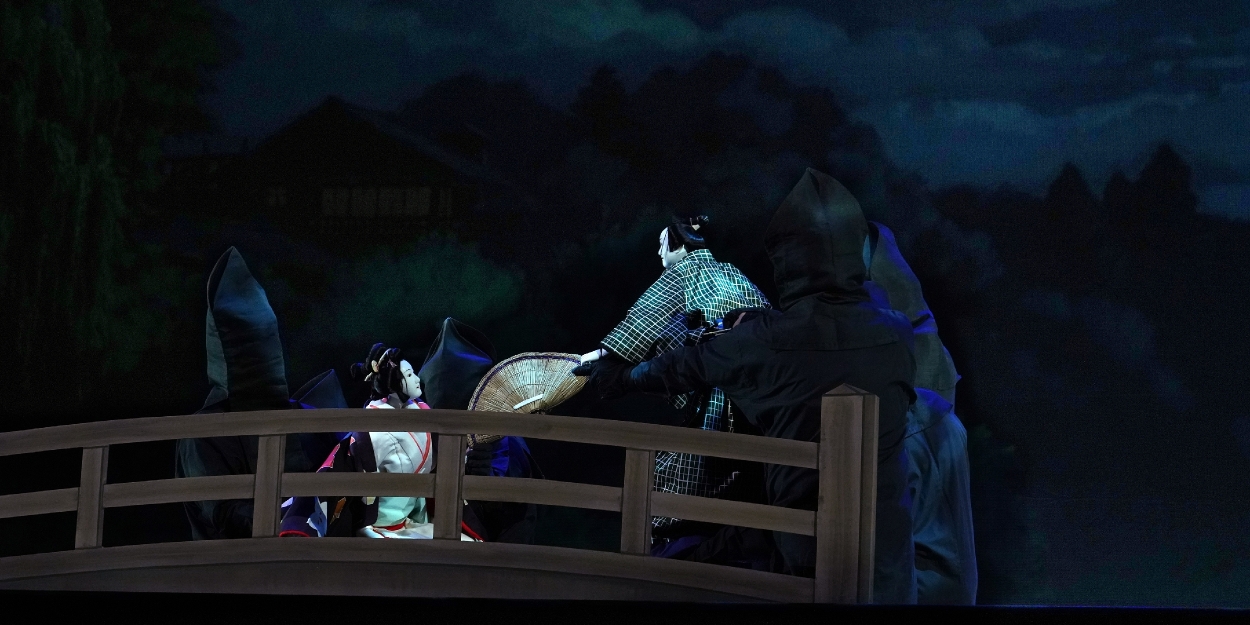Review: NATIONAL BUNRAKU THEATER AT THE KENNEDY CENTER at The Kennedy Center's Terrace Theater
Two performances only - October 8-9, 2024

Economists, in explaining labor productivity, often point to symphony orchestras as examples where it is difficult if not impossible to increase labor productivity. Yes, orchestras may downsize from 30 violins to 25, but it still takes all 25 roughly forty minutes to play Beethoven’s sixth symphony. You could speed up the tempo, increasing “output” with the same number of performers (the orchestra could play it twice in an hour instead of 1.5 times!) but no audience pays to listen to it twice in a row nor wants to hear it played vivace. (Quibblers, my email is included in my bio.)
Tuesday’s performance of National Bunraku Theater from Japan at the Kennedy Center’s Terrace Theater would give productivity nuts a whole new dataset to consider. This puppetry and musical tradition goes back to at least the 19th century and includes a number of unusual conventions that add to the artform’s richness. Each puppet is manipulated by three puppeteers: one for the head, spine and right arm; one for the left arm; and a third for the legs and feet. In the case of female puppets, who have no legs and feet, the puppeteer gives the illusion of legs with intricate handling of the puppet’s kimono. The three puppeteers move in concert, a detailed choreography of its own to bring to life the puppet’s emotions and movements.
This choreography increases with complexity when multiple puppets are onstage interacting, such as during the program’s second piece, The Forest by the Tenjin Shrine scene from Sonezake Shinju (The Love Suicides at Sonezaki). Here 6 puppeteers and two puppets negotiated within what looked to be about four square feet, executing choreographed embraces, soliloquies, and weeping in response to the chants of the three narrators and music of the three shamisen players. There also appeared to be two additional puppeteers moving scenery and costumes. It would be nice to see the company perform on their home stage in Osaka, which I imagine is designed to disguise puppeteers when they are not supposed to be seen. The theater’s retrofitting also seemed to contribute to a longer-than-anticipated intermission as standhands modified the set.
Music and video content enhanced the mood and setting. The shamisen, a three-stringed instrument played like a banjo, is used in many Japanese theatrical traditions. Here the pitch was low and the music varied between staccato moments of excitement with extended trembles of sadness or fear. Entrancing animated scenery by Studio Ghibli artist OGA Kazuo added to the immersive experience of The Forest by the Tenjin Shrine. This integration of old and newer art forms was exciting to see and represents a new chapter in the evolution of bunraku.
The performance also included a demonstration of how the puppeteer’s manipulate the puppet and some explanation of bunraku’s traditions. The demonstration leader noted that National Bunraku Theater adheres to a style of performance known as dezukai in which the lead puppeteer’s face is left visible to the audience. This makes it harder for the puppeteer to go unnoticed (perhaps the point) and singles out the “star” puppeteer. Of the two works on the program, however, only one was performed in the dezukai style with no explanation as to why.
As a longtime dance goer, I’ve honed a set of responses to share when asked to explain pantomime or the structure of a grand pas de deux or the bowing protocol of a ballet company. Watching these artists put me in the novice seat, as I struggled to make sense of the conventions. The subtlety of the puppets’ movements were difficult to see at times, but when I allowed myself to simply take in the overall impression, it was simultaneously emotional, moving, and technically impressive.
The Kennedy Center’s two performances were part of a five-city tour produced by New York’s Japan Society that wraps up next week in Houston, Texas.
Runtime: 1 hour and 35 minutes, with one intermission
Photo Credit: The Love Suicides at Sonezaki. Photo by Tomoko Ogawa.
Reader Reviews
Videos

